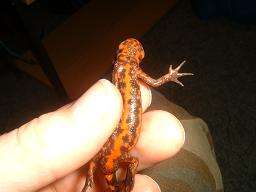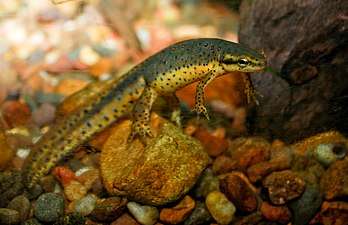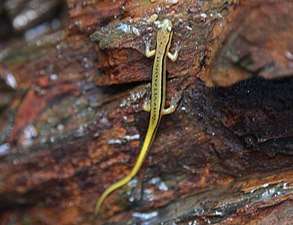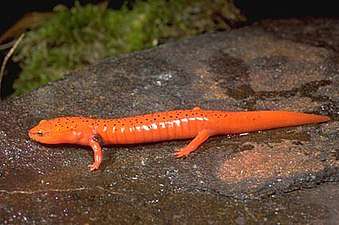Batrachochytrium salamandrivorans
Batrachochytrium salamandrivorans (Bsal) is a pathogenic chytrid fungus that infects amphibian species. salamanders and newts seem to be the most susceptible, however some anuran species are susceptible. Bsal has emerged recently and poses a major threat to species in Europe and North America.
| Batrachochytrium salamandrivorans | |
|---|---|
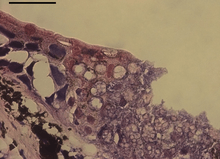 | |
| Bsal infection in the skin of a fire salamander | |
| Scientific classification | |
| Kingdom: | |
| Division: | |
| Order: | |
| Family: | |
| Genus: | |
| Binomial name | |
| Batrachochytrium salamandrivorans Martel A., Blooi M., Bossuyt F., Pasmans F. (2013)[1] | |
It was described in 2013 based on a strain collected from skin tissue of fire salamanders Salamandra salamandra. The pathogen, unidentified up to then, had devastated fire salamander populations in the Netherlands. Molecular phylogenetics confirmed it as related to the well known chytrid B. dendrobatidis. Like this species, it causes chytridiomycosis, which is manifested in skin lesions and is lethal for the salamanders.[1] Damage to the epidermal layer can be extensive and may result in osmoregulatory[2] issues or sepsis[3].

Another study estimated that this species had diverged from B. dendrobatidis in the Late Cretaceous or early Paleogene. While initial susceptibility testing showed frogs and caecilians seemed to be resistant to Bsal infection, it was lethal to many European and some North American salamanders. East Asian salamanders were susceptible but able to tolerate infections. The fungus was also detected in a more-than-150-year-old museum specimen of the Japanese sword-tailed newt. This suggests it had originally emerged and co-evolved with salamanders in East Asia, forming its natural reservoir, and was introduced to Europe rather recently through the trade of species such as the fire belly newts as pets.[4] The asian origin hypothesis for Bsal is supported by additional studies which have found Bsal in wild urodela populations in Asia and in animals of asian origin being transported via the pet trade.[5][6][7]. Since the pathogens initial discovery, it has been found in several additional areas across Europe in both wild and captive populations. One study was able to detect Bsal in 7 of 11 captive urodele collections[8].
The description of this pathogen and its aggressiveness raised concern in the scientific community and the public, fearing that it might be a rising threat to Western hemisphere salamanders.[9][10] On January 12, 2016, the U.S. government issued a directive that prohibited the importation of salamanders in order to reduce the threat posed by B. salamandrivorans.[11]
Etymology
Batrachochytrium is derived from the Greek words batrachos, "frog", and chytra, "earthen pot" (describing the structure that contains unreleased zoospores); salamandrivorans is from the Greek salamandra, "salamander", and Latin vorans, "eating", which refers to extensive skin destruction and rapid death in infected salamanders.[12]
Susceptible Species
The most comprehensive Bsal species susceptibility performed to date has been by Martel et al 2014. [4]. Their experiments demonstrated Bsal susceptibility followed a phylogenetic trend with many Salamandridae species being lethally susceptible. Recent work has demonstrated that some lungless species, specifically those in the Spelerpini tribe might also be clinically susceptible to Bsal [13]
Tolerant
Siren intermedia
Susceptible
Cynops cyanurus
Cynops pyrrhogaster
Paramesotriton deloustali
Lethal
Hydromantes strinatii
Salamandra salamandra
Pleurodeles waltl
Tylototriton wenxianensis
Notophthalmus viridescens
Taricha granulosa
Euproctus platycephalus
Lissotriton italicus
Ichthyosaura alpestris
Triturus cristatus
Eurycea wilderae
Pseudotriton ruber
Information Sources
More information on Bsal and other diseases impacting amphibian populations, including Batrachochytrium dendrobatidis and Ranavirus can be found at the Southeast Partners in Amphibian and Reptile Conservation disease task team web-page.
References
- Martel, A.; Spitzen-van der Sluijs, A.; Blooi, M.; Bert, W.; Ducatelle, R.; Fisher, M. C.; Woeltjes, A.; Bosman, W.; Chiers, K.; Bossuyt, F.; Pasmans, F. (2013). "Batrachochytrium salamandrivorans sp. nov. causes lethal chytridiomycosis in amphibians". Proceedings of the National Academy of Sciences. 110 (38): 15325–15329. doi:10.1073/pnas.1307356110. PMC 3780879. PMID 24003137.

- Voyles, J.; Young, S.; Berger, L.; Campbell, C.; Voyles, W. F.; Dinudom, A.; Cook, D.; Webb, R.; Alford, R. A.; Skerratt, L. F.; Speare, R. (2009). "Pathogenesis of Chytridiomycosis, a Cause of Catastrophic Amphibian Declines". Science. 326 (5952): 582–585. doi:10.1126/science.1176765. ISSN 0036-8075.
- Bletz, Molly C.; Kelly, Moira; Sabino-Pinto, Joana; Bales, Emma; Van Praet, Sarah; Bert, Wim; Boyen, Filip; Vences, Miguel; Steinfartz, Sebastian; Pasmans, Frank; Martel, An (2018). "Disruption of skin microbiota contributes to salamander disease". Proceedings of the Royal Society B: Biological Sciences. 285 (1885): 20180758. doi:10.1098/rspb.2018.0758. ISSN 0962-8452. PMC 6125908.
- Martel, A.; Blooi, M.; Adriaensen, C.; Van Rooij, P.; Beukema, W.; Fisher, M. C.; Farrer, R. A.; Schmidt, B. R.; Tobler, U.; Goka, K.; Lips, K. R.; Muletz, C.; Zamudio, K. R.; Bosch, J.; Lotters, S.; Wombwell, E.; Garner, T. W. J.; Cunningham, A. A.; Spitzen-van der Sluijs, A.; Salvidio, S.; Ducatelle, R.; Nishikawa, K.; Nguyen, T. T.; Kolby, J. E.; Van Bocxlaer, I.; Bossuyt, F.; Pasmans, F. (2014). "Recent introduction of a chytrid fungus endangers Western Palearctic salamanders". Science. 346 (6209): 630–631. doi:10.1126/science.1258268. PMC 5769814. PMID 25359973.
- Cunningham, A. A.; Beckmann, K.; Perkins, M.; Fitzpatrick, L.; Cromie, R.; Redbond, J.; O'Brien, M. F.; Ghosh, P.; Shelton, J.; Fisher, M. C. (2015). "Emerging disease in UK amphibians". Veterinary Record. 176 (18): 468–468. doi:10.1136/vr.h2264. ISSN 0042-4900.
- Laking, Alexandra E.; Ngo, Hai Ngoc; Pasmans, Frank; Martel, An; Nguyen, Tao Thien (2017). "Batrachochytrium salamandrivorans is the predominant chytrid fungus in Vietnamese salamanders". Scientific Reports. 7 (1). doi:10.1038/srep44443. ISSN 2045-2322. PMC 5347381.
- Nguyen, Tao Thien; Nguyen, Thinh Van; Ziegler, Thomas; Pasmans, Frank; Martel, An (2017). "Trade in wild anurans vectors the urodelan pathogen Batrachochytrium salamandrivorans into Europe". Amphibia-Reptilia. 38 (4): 554–556. doi:10.1163/15685381-00003125. ISSN 0173-5373.
- Fitzpatrick, Liam D.; Pasmans, Frank; Martel, An; Cunningham, Andrew A. (2018). "Epidemiological tracing of Batrachochytrium salamandrivorans identifies widespread infection and associated mortalities in private amphibian collections" (PDF). Scientific Reports. 8 (1). doi:10.1038/s41598-018-31800-z. ISSN 2045-2322.
- Stokstad, E. (2014). "The coming salamander plague". Science. 346 (6209): 530–531. doi:10.1126/science.346.6209.530. PMID 25359941.
- Rhodi, Lee (2014-10-31). "Skin-eating fungus Batrachochytrium salamandrivorans threatens to wipe out salamanders worldwide". Tech Times. Retrieved 2015-06-05.
- "Listing Salamanders as Injurious Due to Risk of Salamander Chytrid Fungus". U.S. Fish and Wildlife Service. January 12, 2016.
- "Etymologia: Batrachochytrium salamandrivorans". citing public domain text from the CDC. Emerg Infect Dis. 22 (7): 1282. July 2016. doi:10.3201/eid2207.ET2207. PMC 4918143.
- Carter, E. Davis. "Conservation risk of Batrachochytrium salamandrivorans to endemic lungless salamanders". Conservation Letters. doi:10.1111/conl.12675.
.jpg)
